One of the biggest challenges that Meta advertisers face is running ads that build quality leads that are likely to buy. The wide variation in costs and conversion rate by country is a primary source of this frustration. But there is a solution.
In this post, we’ll discuss the dilemma before I lay out my approach to help you run Meta ads for leads that effectively distribute your budgetA budget is an amount you're willing to spend on your Facebook campaigns or ad sets on a daily or lifetime basis. More to countries that are likely to convert.
Problem #1: Cost Variation by Country
First, let’s accurately define the problem so that you understand what we are attempting to solve here.
Most advertisers understand that when running Meta ads to build leads that you should not target worldwide (all countries). While this is generally accepted, it’s important to understand the factors that can make global targeting problematic. Then, we’ll cover some solutions to counter these problems.
There’s a wide variation in costs to reachReach measures the number of Accounts Center Accounts (formerly users) that saw your ads at least once. You can have one account reached with multiple impressions. More people by country.
The CPMCPM measures the cost per 1,000 impressions. It's a good metric to evaluate competition level and costs to reach your audience. More (Cost Per 1,000 ImpressionsImpressions are the number of times your ads were displayed to your target audience. Impressions aren't counted if it is detected they came from bots. More) can be under $1 for some countries and 30 times that or more in others. The ultimate CPM, of course, will depend on many factors. But the difference between reaching people in the US and India, for example, is significant.
The rate of engagement or lead completion often has a narrow range by country.
The difference in costs isn’t a problem in and of itself. The problem begins because that same disparity doesn’t exist in level of engagement or rate of lead completion. The result of this is that if you optimize for a lead, the algorithm will do all it can to get you the most leads at the lowest cost. And since Meta thinks any lead is a good lead, you can bet that the vast majority of your budget will be spent on the cheapest countries if you target worldwide since that’s the easiest way to get the most leads.
The rate of conversion from lead to paying customer by country is imbalanced.
In theory, getting all of your leads from the cheapest countries to reach isn’t an issue either. Instead, that could be an efficient way to find new customers. That is, of course, if leads convert to paying customers at a similar rate regardless of country.
But that’s not the case. You will likely find that leads will have a wide variance in conversion rate to paying customer depending on the country (among other factors). Some of the most expensive countries to reach are often the countries most likely to convert.
Problem #2: Narrow Focus on Potential Customers
Problem #1 is why many advertisers will focus their budgets on a core group of countries (like the US, UK, Canada, and Australia). While these are generally some of the most expensive countries to reach, they also tend to be more likely to become paying customers.
This approach, though, generates a couple of more issues…
First, that increased cost makes the profitability of lead building far more challenging. You will spend more per lead, and it’s more important that you get a good rate of conversion from the leads that you get.
Second, this assumes that you will only get paying customers from these four countries. That’s often not the case. In an attempt to make your ads more effective, you’ve abandoned countries that have potential to lead to paying customers.
Now that you understand the problems, let’s get to a multi-step solution that you can apply…
1. Research Where Your Paying Customers Live
This is important, especially if you’re an established brand with a history of paying customers to pull from. Actually go through your database, and you might be surprised by what you find.
I ran reports, and I have paying customers in about 100 countries. It’s actually pretty amazing!
Of course, it’s probably best not to commit to targeting a country that only has one or two paying customers, especially if you’ve been running a business for while like I have.
There’s no rule to this, but I made a cutoff at about 20 paying customers. This is my minimum for dedicating budget in a country to build leads.
This left me with 40 countries in all that I can target.
2. Uncover General Costs Per Country
You’ll understand why this is important in a minute. But we need to get a general idea of how much it will cost you to reach each country.
This is going to be imperfect, but it doesn’t need to be perfect. You need a general idea. There are undoubtedly benchmark reports that you can use for this, but I decided to do some manual work on my own.
The first thing I did was I ran a custom ad report for my ad account using the Country breakdownBreakdown is a way to get insights into your ad performance related to time, delivery, action, or dynamic creative element. More. Note that I did this within the custom ad reports instead of Ads Manager since it allows you to view this across your entire account instead of focusing on a single campaignThe campaign is the foundation of your Facebook ad. This is where you'll set an advertising objective, which defines what you want your ad to achieve. More.
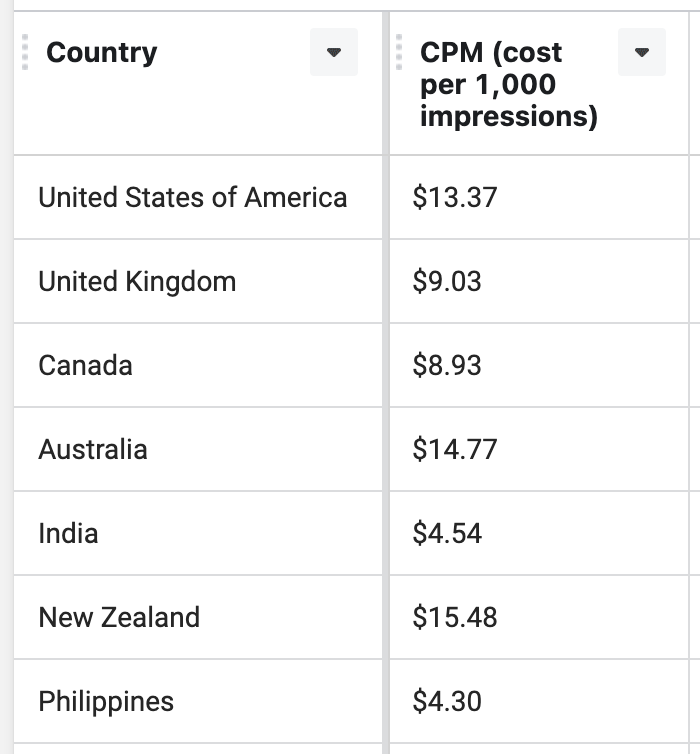
Of course, this is imperfect since it relies on your data and the CPM costs may vary depending on objectiveWhen you create a campaign, one of the first things you'll do is select an objective. The campaign objective is your ultimate goal. Your selection will impact options, including optimization and delivery. Options include Awareness, Traffic, Engagement, Leads, App Promotion, and Sales. More and other factors. But I still find this valuable.
I also used the approach of creating a draft ad set with a $100 daily budget and selecting one country at a time to see how Meta projects impressions.

This will again be imperfect, as you can see from the wide range of impressions. But I used the top of the range for each country to have a consistent point of comparison.
You now have an account-specific CPM and projected impressions per $100 spent to give you an idea of costs to reach a country. If one number feels particularly off, go with the one that seems more accurate.
3. Group Countries by Projected CPM
Now that we have a couple of data points per country, let’s start grouping them together. Our main goal is to prevent wide variations in costs so that the algorithm doesn’t prefer one country over another for the CPM reason alone.
I created five groups in all. Since about half of my customers come from the US, I decided to make it one of my groups by itself.
Here’s an example of the second group…
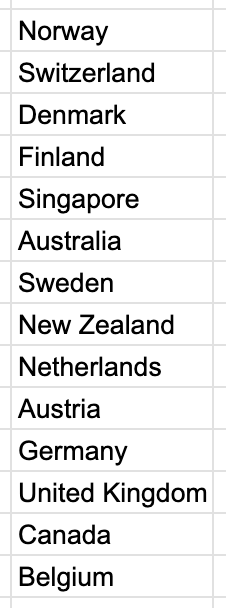
These are the other most expensive countries to reach (beyond the US) of potential paying customers, according to my imperfect research.
4. Create an Ad Set for Each Group
This progression of steps should start to make sense. We are grouping countries together by similar CPM costs so that the algorithm won’t prefer one country over the other. While we don’t demand equal distribution within an ad set, we still want each country to have a chance.
Here are my five ad sets…
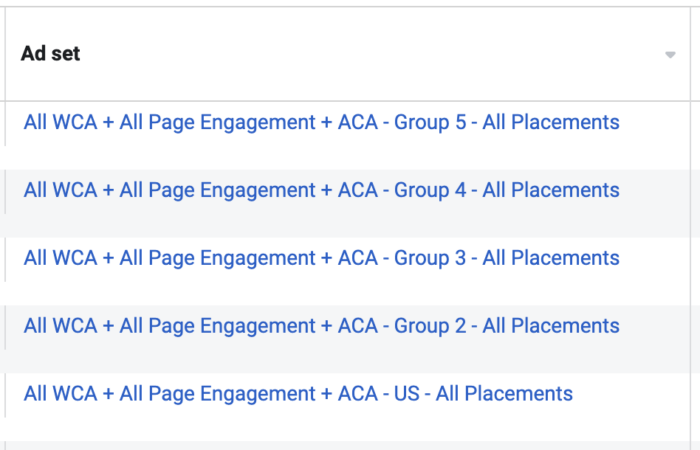
By the name, you can see what my approach is here. I actually used website custom audiencesA website custom audience matches people who visit your website with people on Facebook. You can then create ads to show to that audience. More and engagement custom audiences, but I also turned on Advantage Custom Audience to allow the algorithm to expand beyond those groups. This is actually the first time I’ve used Advantage Custom Audiences. In most cases, I go completely broad for something like this.
Otherwise, everything is pretty straight-forward here. All placements, no manual bidding.
5. Establish Ad Set Budgets
The goal here should be to get the same number of leads per ad set (or it can be your goal). Of course, that wouldn’t mean using the same budget for every ad set since the costs will vary widely by country group.
Look at it this way… I projected that I can reach about 17 times more people when targeting Group 5 than when targeting the US. I set a $40 daily budget for the US, thinking that should get me to at least 50 leads per week. In theory, I only need to spend about $2.35 to get the same number of leads from Group 5.
I went with $3 for Group 5 because even that seems insane. But I can tell you that, incredibly, that’s enough to produce the number of leads I’m wanting from that group.
You can use a formula, but remember that the numbers we’re using for CPM are rough estimations. So feel free to use a bit of your gut here, too.
Here’s what I’m rolling with…
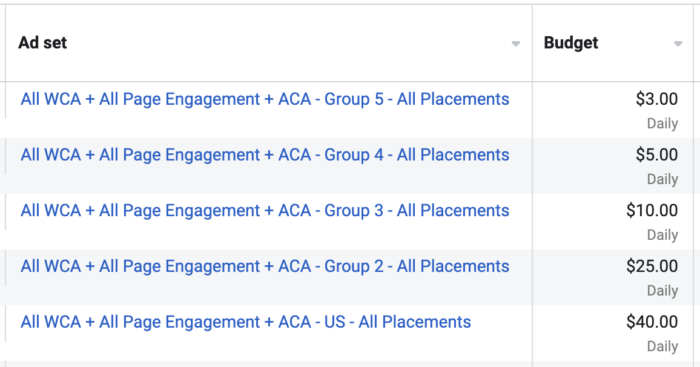
6. Monitor Distribution and Adjust if Necessary
Because these groups are based on some rough projections, it’s quite likely that we’ll run into an issue with imbalanced distribution. Again, we don’t want distribution among countries to be equal within an ad set. We just want to make sure that every country has a chance. Due to population and rate of goal completion, distribution will vary regardless.
What we want to watch for is a country that’s getting nearly all or barely any of the budget. If that happens, check the CPM to see if that may be the cause. We do that by using the breakdown by country in Ads Manager.
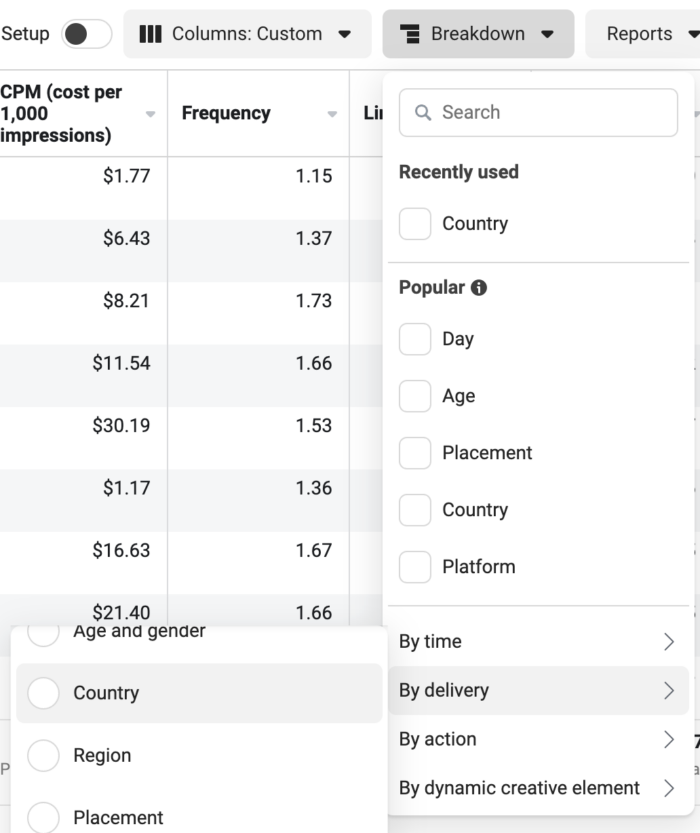
I wouldn’t overreact to small sample size results. Allow your ad setsAn ad set is a Facebook ads grouping where settings like targeting, scheduling, optimization, and placement are determined. More to run for at least a week before making any changes to the composition of countries. When you do make those changes, the learning phase will restart.
If a country isn’t getting enough budget to bring you any leads, consider moving it to the next cheapest country group. On the flip side, if a country is eating up an ad set budget and the CPM is the lowest within the group, consider moving it to the next most expensive ad set.
But I wouldn’t micromanage this. The main thing is that every country is at least generating some leads. You’ll drive yourself crazy if you demand distribution be equal. If that’s the case, just set up an ad set for each country (which I’d only consider with much higher budgets).
A Simplified Version
If the above approach confuses you, let’s consider a much simpler variation.
Assume that instead of 40 countries, you have paying customers in five. For argument’s sake, those five countries have vastly different CPMs. Let’s use this example of countries:
- United States ($15)
- Ireland ($11)
- Brazil ($8)
- Philippines ($5)
- India ($2)
Quite the collection of countries! The CPMs are entirely hypothetical to prove a point.
Since these CPMs are across the board, you probably shouldn’t put them into the same ad set, or the majority of your budget will be spent in India. While India has generated paying customers, you may want to be sure that you also get leads from the United States and other countries on the list.
To accomplish this, you’ll create multiple ad sets. The budget you use for each ad set should be somewhat proportionate to the differences in CPM. With a goal in mind of generating 50 leads per week per ad set and an assumed cost of $5 per lead in the US, we would start with a daily budget of $50 for the United States (this is a starting point with no math behind it).
We can then assemble our other budgets.
- United States: $50
- Ireland: $37
- Brazil: $27
- Philippines: $17
- India: $7
In theory, this could help us get approximately the same number of leads per week from each of these countries that are sources of paying customers.
Find What Works for You
This is all a bit of an experiment for me, so I’m by no means an expert on this approach. But I can tell you that the early returns have been exciting. It’s a nice balance of high-volume cheap leads and lower-volume expensive leads, but they all have the potential to lead to paying customers.
It’s possible that you have far fewer than 40 countries to target. Don’t feel like this needs to be a long list. I only included 40 because I have data showing I should.
It’s also possible that you have a very high budget and you can create more groups. At the extreme, you’d create one ad set per country. Since you’d need an adequate budget to exit the learning phase for every country, that’s going to cost much more than grouping similar countries.
How you do this is up to you. But, experiment and have fun with it!
Your Turn
Have you tried out a similar approach to grouping countries? What do you do differently?
Let me know in the comments below!







